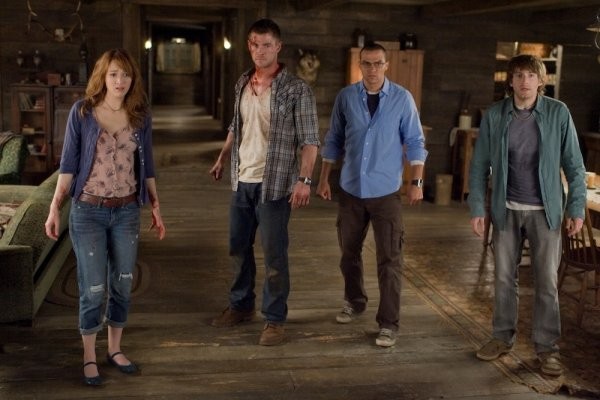Culture
The Bloody Truth: “The Cabin in the Woods”

In The Bloody Truth, every Thursday, Calhoun Kersten looks at the deeper meanings within one of film’s most subtext-heavy genres, horror.
Also, SPOILERS ahead.
The scene opens on a dimly lit cabin, surrounded by overgrown weeds. Perhaps there is a crack of thunder or a hushed whisper. Whatever banal attempts filmmakers pose to add something new to the setup, the setting and the delivery seem all too familiar. That is perhaps one of the greatest jokes at the heart of the Drew Goddard and Joss Whedon-penned The Cabin in the Woods. For all its ingenuity, its fancy bells and whistles, and even its self-awareness, The Cabin in the Woods sells itself on that same tired imagery. After all, why wouldn’t it? It’s a neat little package. Studios know how to sell it. Look at the cult following behind such woodland horror romps like Sam Raimi’s tree-raping opus Evil Dead, or Eli Roth’s ode to pancakes and decaying flesh Cabin Fever. They’re all incredibly different films, but they all sell themselves on that picturesque, rural “paradise” and the horrors that lie behind the façade.
However, The Cabin in the Woods is more than a critique of the American ideals that are represented by the idyllic and isolated cabin. With its self-awareness, The Cabin in the Woods attacks the very genre that it claims to be a part of. It positions itself as a mockery from the very beginning. The “dumb blonde” is replaced with Jules (Anna Hutchison), a hot and intelligent (albeit still blonde) woman. The archetypal “Final Girl” Jules (Kristen Connolly) is known to be sexually active, as evidenced by her inferred affair with her professor. All of these elements help to establish the elaborate joke that the audience is in on. When things start to go awry, the audience understands how their eventual out-of-character actions are manifestations of their prescribed roles, at the hands of the omnipotent Sitterson (Richard Jenkins) and Hadley (Bradley Whitford).
When The Cabin in the Woods first started garnering critical attention, it was hailed as one of the most original horror movies of the year, perhaps even the decade. Ironically, it isn’t. Is it inventive? Yes. Is it creative? Absolutely. Is it original? Lord, no. Even ignoring the numerous references made to The Evil Dead throughout the film, The Cabin in the Woods is literally an amalgamation of various horror tropes. Granted, they are reappropriated, but the tropes still serve their original function of providing karmic justification for a character’s death.
This seems to be the most elaborate joke of the film. As much as Goddard and Whedon are creating fully-formed characters, certainly a rarity in the horror genre, they are subjecting them to the will of… well, themselves. Whedon and Goddard have been outspoken in interviews about the fact that Sitterson and Hadley are essentially stand-ins for Whedon and Goiddard. Much like the victims of the film, Sitterson and Hadley exercise control over their environment, subjecting Jules and Dana as well as the others to their influence.
However, self-aware horror is by no means a new concept. Look how often Robert Englund is cast as the creepy guy because of his past role as Freddy Krueger. No, a level of awareness has always been necessary to truly enjoy horror films. For instance, Alex Browning, the male lead in Final Destination, may seem inconsequential to most viewers, but director James Wong intended his name to be a reference to famed 1931 Dracula director Tod Browning. These elements, while they may not detract from a casual viewing experience, add to the intricacies of the horror genre. It’s not funny because Whedon and Goddard are being self-aware. It’s funny because so many people credit them as having invented this technique.
In reality, what The Cabin in the Woods seems to be saying is that their film is capitalizing on the tail end of this craze. Meta-horror narratives entered the mainstream as early as Wes Craven’s 1996 slasher film Scream. Sure, other self-aware attempts may not have garnered as much publicity, but there have been countless movies that have tackled this material, such as the rarely-seen All the Boys Love Mandy Lane or the underrated Behind the Mask: The Rise of Leslie Vernon. Goddard and Whedon seem to be aware that they are in good company, which is why the film ends the way that it does. On a larger scale, The Cabin in the Woods represents the horror film scene as a whole. When faced with itself, the horror genre has no choice but to collapse. The Cabin in the Woods is, in a sense, an eulogy to the horror genre, its numerous incarnations and the conventions that make it so readily recognizable. When you look it that way, it’s no wonder that the world ends.